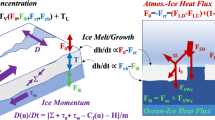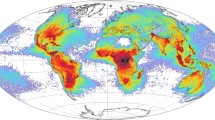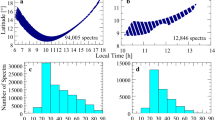Abstract
Farman et al.1 have reported a rapid decrease, since their measurements started in 1957, of the total column amount of ozone in late winter and early spring over the Halley Bay station in Antarctica (76° S, 27° W). The decrease was most pronounced in October, early spring in the Southern Hemisphere. They attributed the decrease to the increase in stratospheric chlorine due to chloro-fluorocarbon release, and proposed that the unique conditions of extreme cold and low sunlight in the Antarctic winter and spring enhanced the effect. We report measurements from the Solar Backscatter Ultraviolet (SBUV) instrument and the Total Ozone Mapping Spectrometer (TOMS) aboard the Nimbus 7 satellite, a Sun-synchronous polar-orbiting satellite which passes any given point on the dayside near local noon. These provide global measurements of ozone from November 1978 to the present which confirm the reported decline of total ozone and show the phenomenon to be regional in extent. The decrease occurs during September as the Sun rises, reaching a minimum in mid-October. Seven years (1979–1985) of October monthly means show a 40% decrease in the ozone minimum and a 20% decrease in the surrounding ozone maximum.
This is a preview of subscription content, access via your institution
Access options
Subscribe to this journal
Receive 51 print issues and online access
$199.00 per year
only $3.90 per issue
Buy this article
- Purchase on Springer Link
- Instant access to full article PDF
Prices may be subject to local taxes which are calculated during checkout
Similar content being viewed by others
References
Farman, J. C., Gardiner, B. G. & Shanklin, J. D. Nature 315, 207–210 (1985).
Heath, D. F., Krueger, A. J., Roeder, H. A. & Henderson, B. D. Opt. Engng 14, 323–330 (1975).
Klenk, K. F. et al. J. appl Met. 21, 1672–1684 (1982).
Dave, J. V. J. atmos. Sci 35, 889–911 (1978).
Iwasaka, Y. et al. Middle Atmosphere Program Handbook, Vol. 18 (ed. Kato, S.) 450–452 (SCOSTEP Secretariat, Urbana, 1985).
McCormick, M. P., Steele, H. M., Hamill, P., Chu, W. P. & Swissler, T. J. J. atmos. Sci. 39, 1387–1397 (1982).
Sticksel, P. R. Mon. Weath. Rev. 98, 787–788 (1970).
Hasebe, F. in Dynamics of the Middle Atmosphere(eds Holton, J. R. & Matsuno, T.) 445–464 (Terra Scientific, Tokyo, 1984).
Hilsenrath, E. & Schlesinger, B. M. J geophys. Res. 86, 12087–12096 (1981).
Chubachi, S. in Atmospheric Ozone (eds Zerefos, C. S. & Ghazi, A.) (Reidel, Dordrecht, 1984).
Miller, A. J., Finger, F. G. & Gelman, M. E. NASA tech. Memo. No. TMX-2109 (Washington, DC, 1970).
Rood, R. B. Pure appl. Geophys. 121, 1049–1064 (1983).
Solomon, S., Garcia, R. R., Rowland, F. S. & Wuebbles, D. J. Nature 321, 755–758 (1986).
McElroy, M. B., Salawitch, R. J., Wofsy, S. C. & Logan, J. A. Nature 321, 759–762 (1986).
Tung, K. K., Ko, M. K. W., Rodriguez, J. M. & Sze, N. D. Nature 322, 811 (1986).
Author information
Authors and Affiliations
Rights and permissions
About this article
Cite this article
Stolarski, R., Krueger, A., Schoeberl, M. et al. Nimbus 7 satellite measurements of the springtime Antarctic ozone decrease. Nature 322, 808–811 (1986). https://doi.org/10.1038/322808a0
Received:
Accepted:
Issue Date:
DOI: https://doi.org/10.1038/322808a0
This article is cited by
-
Century-long column ozone records show that chemical and dynamical influences counteract each other
Communications Earth & Environment (2022)
-
Climate change as a wicked social problem
Nature Geoscience (2016)
-
An atmospheric origin of the multi-decadal bipolar seesaw
Scientific Reports (2015)
-
Comparison of Suomi-NPP OMPS total column ozone with Brewer and Dobson spectrophotometers measurements
Frontiers of Earth Science (2015)
Comments
By submitting a comment you agree to abide by our Terms and Community Guidelines. If you find something abusive or that does not comply with our terms or guidelines please flag it as inappropriate.



